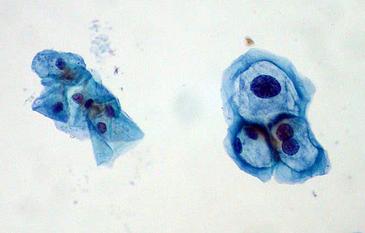HIV-positive men show high rates of papillomavirus infection at oral, anal and penile sites
Scientists in Barcelona have found a high presence of papillomavirus infection in oral, anal and penile cavities in
HIV-positive men, particularly in the anal cavities of men who have homosexual sex. The researchers recommend routine examination of
the three areas in all men, independently of their sexual behaviour.
 June 25 2013 - HIV-carrying
men are more frequently co-infected by human papillomavirus (HPV) in oral, anal and penile sites, according to a study published in the
journal 'Sexually Transmitted Diseases' carried out by scientists from the Autonomous University of Barcelona, the Lluita Contra la
SIDA (Fight Against AIDS) Foundation and the IrsiCaixa Foundation (Spain). June 25 2013 - HIV-carrying
men are more frequently co-infected by human papillomavirus (HPV) in oral, anal and penile sites, according to a study published in the
journal 'Sexually Transmitted Diseases' carried out by scientists from the Autonomous University of Barcelona, the Lluita Contra la
SIDA (Fight Against AIDS) Foundation and the IrsiCaixa Foundation (Spain).
Prevalence and incidence of the virus, although significant in all groups of seropositive men, is especially high in the anal
canal among men who have sex with men (MSM). The results have led the scientists to recommend routine medical anal, oral and penile
examinations regardless of sexual behaviour and practices.
The study analysed year by year, between 2005 and 2009, the presence of papillomavirus among 733 male patients with HIV
at the Germans Trias i Pujol Hospital in Badalona. 538 of these patients had had homosexual sex. The researchers also studied the rate
of new infections and clearance of the virus over the four-year study.
Prevalence - the number of cases in the sample studied - was 73% in anal, 26% in penile and 16% in oral sites, and
incidence - new cases arising over the time span of the study - was 36%, 17% and 11% respectively.
These figures reveal that HPV infection in seropositive men is more frequent than in the healthy population where,
according to data from previous research, the prevalence of anal infection is 47% in MSM and 12% in heterosexuals, 4.8% in oral
and 26% in penile sites.
"The results demonstrate high prevalence and incidence of HPV infection in these three sites, and a low clearance
rate," Guillem Sirera, main author and researcher at the Department of Internal Medicine of the Germans Trias i Pujol Hospital
in Badalona, explains to SINC.
"Because of their sexual behaviour, MSM present higher prevalence (84%) and incidence in the anal canal and a
lower clearance percentage than heterosexuals," Sirera affirms, but clarifies that even so, prevalence in heterosexuals was
also high (42%).
"The prevalence of HPV infection - especially in anal sites - in MSM was to be expected, but prevalence in the heterosexual
group was unexpected," the researcher remarks.
HPV is linked to cancer
In other sites, prevalence, incidence and clearance were similar for both groups, and co-infection in all three sites was
similar at 7% in heterosexuals and 6% in MSM.
The HPV virus has been linked to certain cancers, such as cervical, anal and penile cancers. Some of these conditions
appear more frequently in the HIV-positive population. Men who have homosexual sex are particularly susceptible to anal cancer.
The immunosuppressive effects of HIV infection make colonisation of the anal canal and penis by HPV more likely. Extended
treatment with antiretrovirals improves the immunological conditions of patients with HIV. However, although the study found lower
prevalence of HPV infection in anal sites in patients treated with these drugs, this was a weak effect.
According to Sirera, independently of sexual behaviour, "oral, penile and anal examinations should be conducted for
all HIV-positive patients during their annual clinical visits in order to discount any HPV-related disease." The presence of the
virus can be detected by the presence of condylomata - genital warts -, by smear test or by PCR technology.
###
Referencia bibliográfica:
Sebastian Videla, Laila Darwich, Mari-Paz Cañadas, Josep Coll, Marta Piñol, Francesc García-Cuyás, Rafael A. Molina-Lopez, Patricia Cobarsi, Bonaventura Clotet, and Guillem Sirera. "Natural
History of Human Papillomavirus infections involving anal, penile, and oral sites among HIV-positive men", enero 2013, Sexually Transmitted
Diseases. DOI: 10.1097/OLQ.0b013e31827e87bd
Source: SINC
For more HIV and AIDS News visit...
Positively Positive - Living with HIV/AIDS:
HIV/AIDS News
|